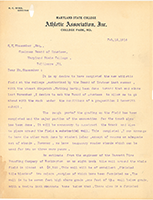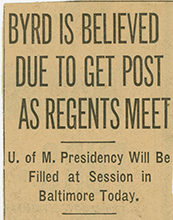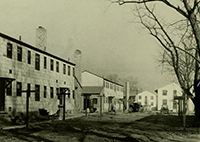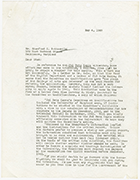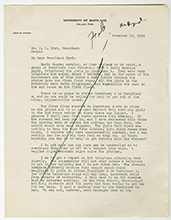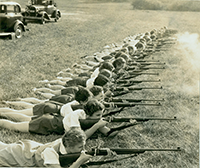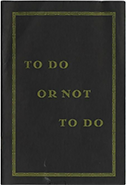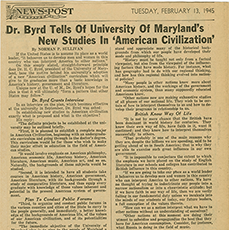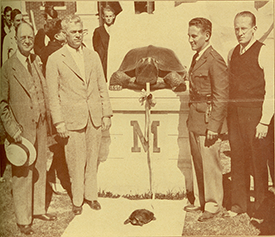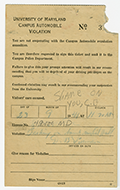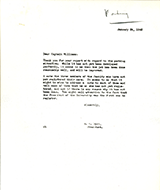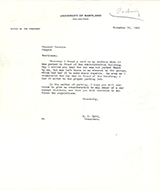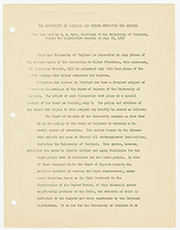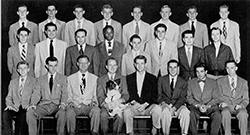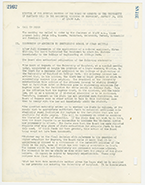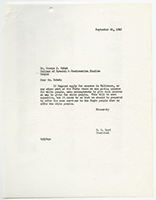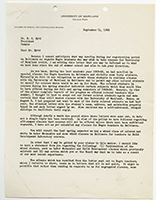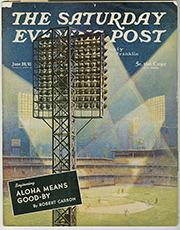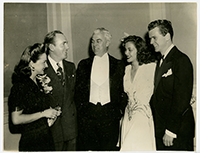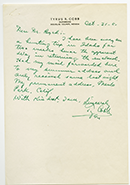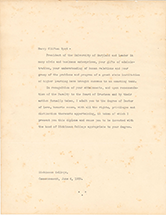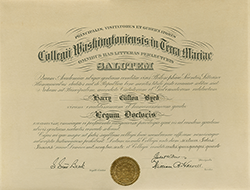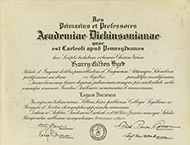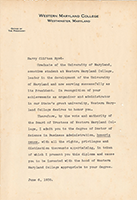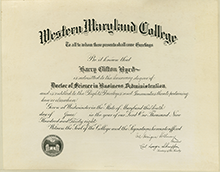Impact on UMD:
Administrator
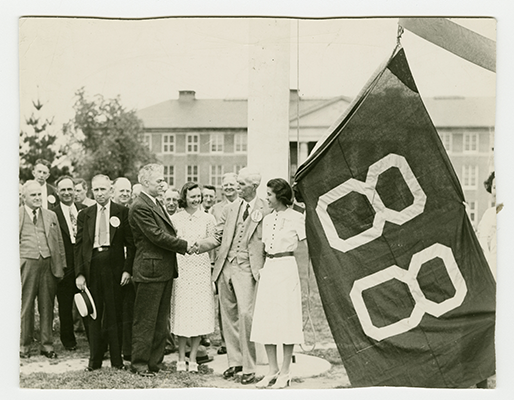
Harry Clifton Byrd was a tireless advocate for the University of Maryland. He gave his attention equally to issues of importance, such as the integration of the university, the introduction of new courses of study, the fight for a Phi Beta Kappa chapter, and the establishment of a new branch of the university, as well as to matters deemed trivial by many, such as parking and the installation of screens in the windows of girls' dormitories. Samuel M. Shoemaker, chair of the Board of Regents, in a letter to Byrd dated June 17, 1930, noted his “usual routine of eighteen to twenty hours a day,” and his energy and creativity as an administrator were indeed legendary.
Although Byrd’s main focus was the College Park campus, he was also responsible for the operation of the university’s professional schools, law, medicine, dentistry, pharmacy, and nursing, in Baltimore and the Princess Anne Academy, which served African-American students. He was involved in numerous personnel decisions, fundraising efforts, and construction projects at both institutions. Byrd also worked to improve educational opportunities at Princess Anne, now known as the University of Maryland Eastern Shore, to provide a solution to the problem of higher education for African-American students in Maryland.
Click below to view enlarged images
Byrd was always seeking improvements in his alma mater. In 1916, in his role as director of athletics, he wrote this three-page letter to the chairman of the Board of Trustees of the Maryland State College of Agriculture, as the University of Maryland was then known, outlining his ideas for the enhancement of athletic facilities on campus.
From the records of the Board of Regents.
The Board of Regents named Byrd president on February 21, 1936, by a vote of seven to two. After learning of the regents' decision, Byrd left the board room, telling a reporter from the Washington Star that "I have nothing to say...except that I know I have a real job ahead of me."
From the papers of Adele Stamp.
Byrd never forgot the importance of the university's alumni, always reaching out to them and making them feel welcome on campus. Here he greets Melvin C. Hagen, Class of 1888, during the class's fiftieth reunion in 1938.
From the University Archives photograph collection.
One of the greatest challenges of Byrd's presidency was dealing with the incredible influx of veterans taking advantage of the educational opportunities opened up by the G. I. Bill in the aftermath of World War II. The lack of adequate facilities was a particular problem. Temporary living quarters for the vets and their families sprang up in the communities surrounding the university, like this complex on Norwich Road, and bunk beds filled the Armory floor. In one week in September 1946, enrollment in the university nearly doubled from 6,080 the previous June to 11,050. Classrooms were crammed full, and students waited in line for hours to eat in the dining hall.
From the 1948 Terrapin yearbook and the University Archives photograph collection.
Byrd's 31- page personal plea for the establishment of Phi Beta Kappa at the University of Maryland, May 4, 1949. Unfortunately the honorary did not charter a chapter at the university until December 16, 1964, more than ten years after Byrd became president emeritus.
From the personal papers of Harry Clifton Byrd.
Byrd felt no problem or issue was too insignificant to deserve his attention. In this letter to Byrd, Dean of Women Adele Stamp recorded difficulties encountered with a group of "hilarious and noisy" boys, whom she believed to be drunk, returning from a party and frightening girls in the dormitories. Dean Stamp pleaded for the installation of window screens and telephones to be used for daily and emergency communication.
From the papers of Geary Eppley.
Women’s rifle team, c. 1930s. Byrd's tenure at the university saw many changes in higher education for women. From the admission of the first female undergraduates in 1916, through a strict code of conduct that lasted into the 1960s, to the admission of women into non-traditional majors like engineering and the hard sciences, Byrd saw the lives of co-eds at Maryland change dramatically.
From the University Archives photograph collection.
May Day procession, 1949. During his tenure as president, Byrd saw the lives of co-eds change dramatically, both academically and socially. The university encouraged a variety of activities for women, both traditional and non-traditional, including the annual May Day festivities, started by Adele Stamp in 1923.
From the University Archives photograph collection.
"To Do or Not to Do," published in 1937 and 1940 by the Women's League at the University of Maryland. In this publication, the league described proper behavior for young ladies in a variety of commonly encountered campus situations, such as studying in the library, eating in the dining hall, and saying hello and good night. Female students were required to follow a strict code of conduct throughout Byrd’s presidency.
From the University Publications collection.
Newspaper clipping describing one of Byrd's major accomplishments during his presidency, his introduction of course work in "American Civilization." These classes placed the university in the forefront of a major, nationwide change in the higher education curriculum and encouraged interdisciplinary studies. This program did not develop precisely as Byrd had hoped, but remnants of this curriculum still remain in today's American Studies department.
From the papers of Adele Stamp.
Biennial report of the College of Special and Continuation Studies, Daytime Program in Munich, 1953-1954. One of Byrd's lasting accomplishments was the establishment, in 1946, of the College of Special and Continuation Studies (CSCS), known today as University of Maryland University College. The CSCS originally began as an effort to assist working people in furthering their education at night and to provide educational opportunities for individuals with less-than-stellar previous academic records but great potential. The college spread around the world to military bases and American embassies and established other satellite campuses, allowing thousands of older students to receive a college degree.
From the records of the University of Maryland System President's Office.
Byrd played a key role in the selection of the diamondback terrapin as the University of Maryland mascot. Byrd is shown here at the original statue's unveiling in June 1933 with (left to right) President Raymond A. Pearson and students Ralph Williams and Edward Quinn, president and president-elect of the Student Government Association.
From the University Publications Collection.
No matter was too small to receive the president's attention, and parking, a perennial problem at the university, was no exception. Here he chides Captain Ralph Williams about the failure of three faculty members to register their cars and protests a parking ticket he received in front of the Administration Building.
From the records of the University of Maryland System President's Office.
Byrd’s testimony on the University of Maryland and higher education for Negroes to the Legislative Council, July 6, 1947. The education of African American students in the state of Maryland and at the University of Maryland was one of the most difficult challenges that Byrd faced throughout his entire administrative career. He expended considerable amounts of his energy and university resources on improving the facilities and programs at the Princess Anne Academy, known today as the University of Maryland Eastern Shore. He addressed legal challenges to the university's admission policies and testified before legislative committees. Above all, he clearly understood the need to resolve the question of integration of the University of Maryland and the far-reaching implications such decisions would have, as exemplified at the conclusion of the 50 pages of testimony to the Legislative Council.
From the personal papers of Harry Clifton Byrd.
Hiram Whittle, shown here with his fellow residents of Temporary Dormitory One, became the University of Maryland's first African American undergraduate student when he began classes at College Park in the spring of 1951. Whittle was admitted when the Board of Regents formally recognized that no facilities for engineering existed at the university's Princess Anne campus and stated that "what has been done heretofore neither gives the Negro what he is entitled to nor prevents him entering the University of Maryland," echoing nearly word for word Byrd's testimony to the Legislative Council in 1947.
From the 1952 Terrapin yearbook.
Excerpt from the minutes of the Board of Regents, noting the admission of Hiram Whittle, January 31, 1951.
From the Records of the Board of Regents.
Correspondence between C.O. Appleman, Dean of the Graduate School, George J. Kabat, Director of the College of Special and Continuation Studies, and President Byrd regarding offering courses to African American students in Baltimore. June and September 1948. These offerings occurred three years in advance of the admission of African Americans to the College Park campus.
From the Records of the University of Maryland System’s President’s Office.
President Byrd received significant coverage in the national press. This issue of the Saturday Evening Post, dated June 28, 1941, features an article by Bob Considine entitled "Curley Byrd Catches the Worm." In this piece, Considine regales his readers with tales of "Curley" Byrd's early years, his exploits as an athlete, and his administrative and political savvy.
From the Sterling Byrd Collection.
Byrd's powerful presence was everywhere, even in combat in the Far East during World War II, as evidenced by the inscription on the side of this plane.
From the personal papers of Harry Clifton Byrd.
Byrd's charisma and charm were legendary, and he cut quite the figure on the national scene. Here he chats with film stars Pat O'Brien, Jackie Cooper, Carol Bruce, and Bonita Granville at a March of Dimes banquet in the late 1930s.
From the personal papers of Harry Clifton Byrd.
Letter from baseball Hall of Famer Tyrus “Ty” Cobb, one of the numerous prominent individuals with whom Byrd had contact, October 31, 1951. Byrd and Cobb worked together in the early 1950s on a panel of the federal Salary Stabilization Board that examined the structure of professional athletes’ salaries. Here Cobb apologizes to Byrd for his delay in responding to the group’s final report.
From the records of the University of Maryland System President’s Office.
Newspaper coverage of the Washington College commencement ceremony at which Byrd received his honorary degree, June 9, 1936.
From the Papers of Adele Stamp.
Honorary Doctor of Laws degree citation, Dickinson College, June 6, 1938. Dickinson recognized Byrd’s “gifts of administration.” “understanding of human relations,” and “grasp of the problems and program of a great state institution of higher learning.”
From the personal papers of Harry Clifton Byrd.
Honorary doctor of laws degree Byrd received from Washington College in Chestertown, Maryland on June 8, 1936, the first of three honorary degrees he was awarded. He never received a Ph.D. of his own, but he was often referred to as Dr. Byrd. In presenting the degree, President Gilbert W. Mead described Byrd as “a statesman in education.”
From the personal papers of Harry Clifton Byrd.
Honorary Doctor of Laws degree Byrd received from Dickinson College, June 6, 1938.
From the personal papers of Harry Clifton Byrd.
Western Maryland College, now known as McDaniel College, awarded Byrd an honorary Doctor of Science degree on June 6, 1938. The college noted Byrd’s “achievements as organizer and administrator in our State’s great university” in its degree citation, as well as the fact that Byrd had taken some classes at Western Maryland following his graduation from Maryland Agricultural College.
From the personal papers of Harry Clifton Byrd.
Byrd’s honorary doctor of science degree from Western Maryland College, now known as McDaniel College, awarded June 6, 1938.
From the personal papers of Harry Clifton Byrd.


